Key messages:
CHAPTER 1 - SUSTAINABLE DEVELOPMENT GOAL 2.1: UNDERNOURISHMENT AND FOOD INSECURITY
Hunger in the Arab States reached its highest value in 2022 since 2000. The number of undernourished people was 59.8 million in 2022, 75.9 percent higher than in 2000. This corresponded to 12.9 percent of the population in 2022, well above the world average of 9.2 percent.
The prevalence of undernourishment (PoU) was the highest in low-income countries and Arab States least developed countries (LDCs), where almost every third person suffered from hunger. Somalia had the highest PoU level (48.7 percent), followed by Yemen (34.5 percent), and the Syrian Arab Republic (27.8 percent). Undernourishment in conflict countries (23.6 percent) was almost four times higher than in non-conflict countries (6.6 percent) in 2022. In upper-middle-income countries, hunger was also higher (16.3 percent) than the average of Arab States. Undernourishment is less frequent in lower-middle-income countries (6.6 percent). High-income countries had a very low level of PoU (2.8 percent).
Hunger in the Arab region reached its lowest level in 2010, before the Arab Spring, when 9.7 percent of the region’s population suffered from hunger. PoU rose sharply, by one-third from 2010 until 2022, which has been driven mainly by the increase in hunger in upper-middle-income countries and lower-middle-income countries due to socio-economic and commodity price shocks, such as the effects of the Arab Spring, the increase of food prices in 2007–2011, and recently the COVID-19 pandemic and the war in Ukraine.
Moderate or severe food insecurity affected 170.1 million people, or 36.6 percent of the population in 2022, a slight decrease from 2021, when 173.3 million people, or 37.9 percent of the population were food insecure, deprived of regular access to sufficient and nutritious food. In 2022, 61.0 million people suffered from severe food insecurity, which is another measure that approximates hunger. This is an increase of 3.8 million people from the previous year.
Recent trends in hunger and food insecurity suggest that the region is not on track to achieve Zero Hunger (SDG 2) by 2030.
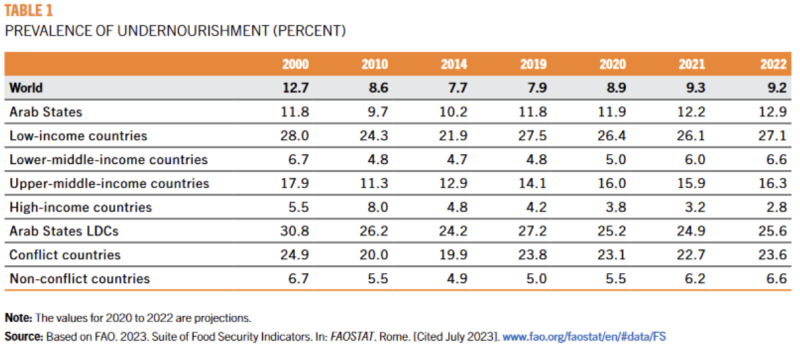
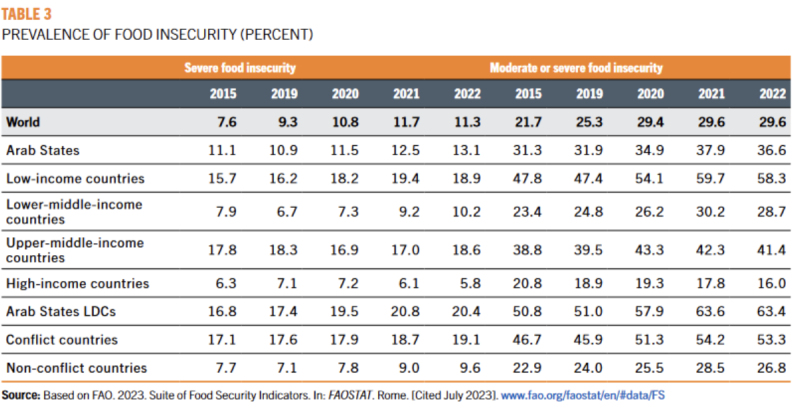
CHAPTER 2 - SUSTAINABLE DEVELOPMENT GOAL 2.2: MALNUTRITION
The Arab region continued to suffer from multiple forms of malnutrition. The prevalence of stunting among children under 5 years of age was 19.9 percent in 2022. The prevalence of overweight (9.5 percent) among children under 5 years of age and the prevalence of anaemia among women aged 15 to 49 years were higher than the world average in 2022.
Arab LDCs and low-income countries had the highest level of stunting, 31.2 percent and 30.5 percent, respectively. Prevalence of stunting in conflict countries (26.5 percent) was almost two times higher than in non-conflict countries (14.7 percent). High-income countries had the lowest prevalence of stunting (10.8 percent) in 2022. The region is off-track in meeting the intermediate SDG 2.2.1 or WHA target, reducing the prevalence of stunting by 40 percent by 2025 (from 2012 levels). Child stunting decreased only by 16.0 percent between 2012 and 2022, from 23.7 percent to 19.9 percent.
Wasting was 3.0 percent in lower-middle-income countries, 2.4 percent in upper- middle-income countries, 4.7 percent in high-income countries, and 3.2 percent in non- conflict countries. Low data availability prevented the calculation of average wasting values for the Arab States, low-income countries, Arab States LDCs, and conflict countries. However, as wasted children are more likely to live in low- or lower-middle- income countries, wasting was probably higher in these country groups.
The prevalence of overweight among children under the age of 5 was highest in lower-middle-income countries (14.4 percent), followed by high-income countries (9.5 percent) and upper-middle-income countries (8.7 percent), although the differences are non-significant. Child overweight was the lowest in Arab LDCs (2.4 percent) and low-income countries (3.6 percent). Overweight among children in conflict countries was almost a third of non-conflict countries. Overweight more than doubled among high-income countries between 2000 and 2022. Most Arab States are far from achieving the 2030 target of less than 3 percent.
The prevalence of anaemia among women aged 15 to 49 years was higher in the Arab States (33.3 percent) than the world average (29.9 percent). Anaemia was the highest in Arab LDCs (45.9 percent) and in low-income countries (43.9 percent), and it was the lowest in high-income countries (27.1 percent) in the Arab States. The reduction in the prevalence of anaemia in the Arab States (-12.9 percent) was three times higher than the global average (-4.2 percent) between 2000 and 2019.
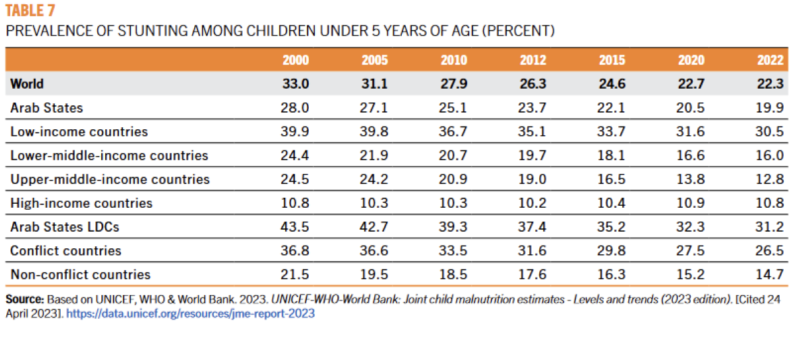


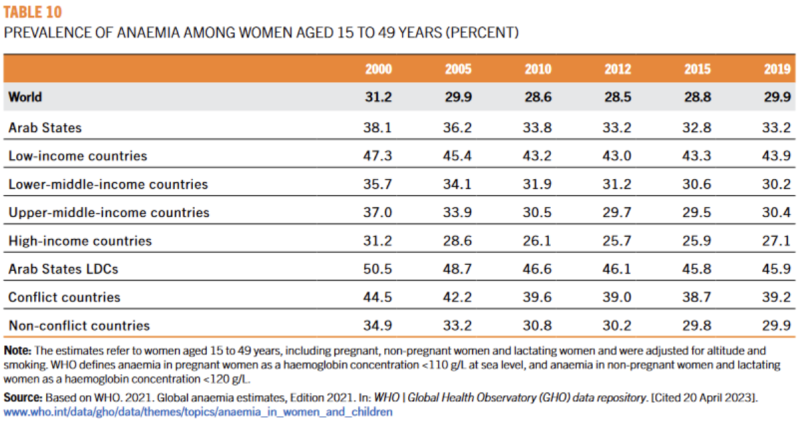
CHAPTER 3 - ADDITIONAL WORLD HEALTH ASSEMBLY NUTRITION INDICATORS
In 2016, in the Arab States, obesity among adults 18 years and older was 27.6 percent, more than double the global prevalence of 13.1 percent. Obesity in adults increased significantly in the Arab States between 2000 and 2016 by 10 percentage points. Adult obesity varied by income group with the highest prevalence in high income countries (33.0 percent). The lowest prevalence was in low-income countries (18.1 percent) and Arab States LDCs (11.8 percent).
In 2012, in the Arab States, the rate of exclusive breastfeeding of infants under six months was 34.6 percent, below the world average of 37.0 percent. Among the subregions the highest rate was in lower-middle-income countries at 39.7 percent and the lowest rate in upper-middle-income countries at 19.9 percent.
In the Arab States the prevalence of low birthweight was 13.3 percent in 2020, with only marginal decreases in the region and subregions since 2012. The subregions were all below the global estimate, with the highest prevalence in lower-middle-income countries at 13.8 percent, and the lowest prevalence in high-income-countries at 10.7 percent.
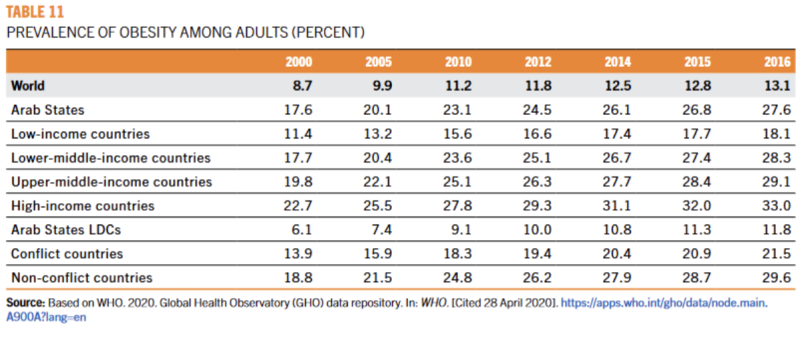
CHAPTER 4 - UPDATES TO THE COST AND AFFORDABILITY OF A HEALTHY DIET
The cost and affordability of a healthy diet continues to be challenging. Continued monitoring of these indicators will remain important in light of recent global shocks threatening food security (FAO, 2023c).
The cost of a healthy diet in the Arab States in 2021 was 3.55 PPP dollars per person per day, slightly lower than the global estimate of 3.66 PPP dollars.
Since 2017, the cost of a healthy diet in the Arab States has increased annually, with a 2.5 percent increase between 2020 and 2021. The highest increase was in high-income countries (6.4 percent), followed by lower-middle-income-countries (4.4 percent), and upper-middle-income countries (3.5 percent).
In 2021, 43.8 percent of the region’s population or 141.6 million people, could not afford a healthy diet. In Arab LDCs, 82.9 percent of the population were unable to afford a healthy diet; nearly twice that of lower-middle-income countries (44 percent), and more than five times that of upper-middle-income countries (16.1 percent).

| Year of publication | |
| Authors | |
| Geographic coverage | North AfricaMiddle East |
| Originally published | 22 Jan 2024 |
| Related organisation(s) | FAO - Food and Agriculture Organization of the United NationsWFP - World Food ProgrammeWHO - World Health OrganisationUNICEF - United Nations Children's FundIFAD - International Fund for Agricultural Development |
| Knowledge service | Metadata | Global Food and Nutrition Security | Food security and food crises Nutrition | Food systems transformationCost of the dietFood price crisisHealthy dietUndernutrition |
| Digital Europa Thesaurus (DET) | policymakingmalnutritionIndicatorSustainable development goalswar in Ukraineprice of agricultural produceagricultural trade |
